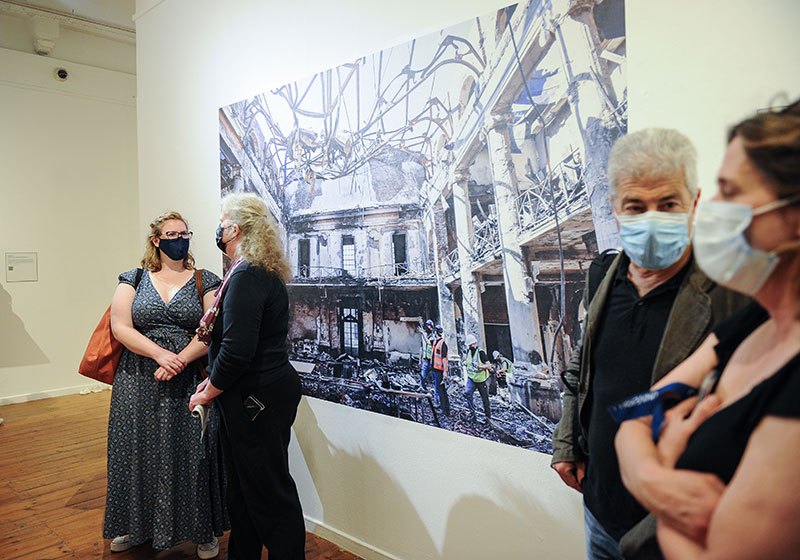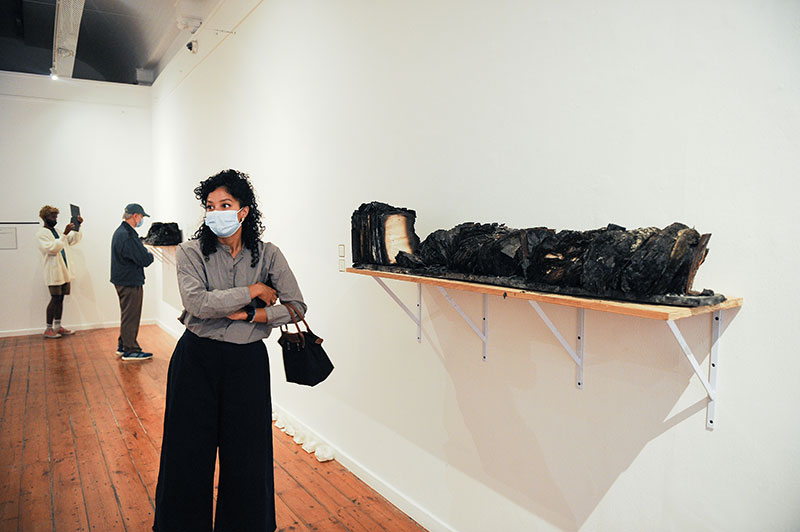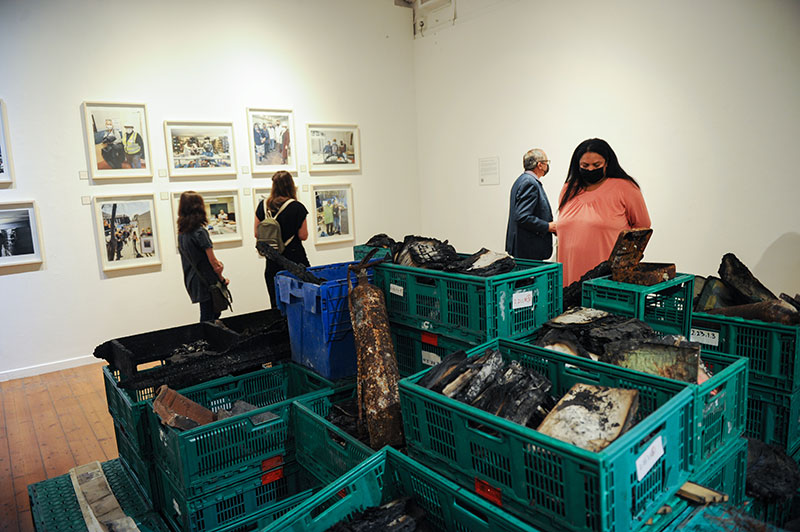‘Of Smoke & Ash’ exhibition a visceral reminder of loss – and hope
28 April 2022 | Story Helen Swingler. Photos Lerato Maduna. Director Roxanne Harris & Rozanne Engel. Videography Jayson Bayard & Ruairi Abrahams. Voice Cwenga Koyana. Read time 8 min.The Of Smoke & Ash exhibition offers an immediate and visceral experience; the faint smell of charred paper, wood and other material irreparably damaged after fire destroyed much of the Jagger Library last year. In this first anniversary memorial exhibition at the University of Cape Town’s (UCT) Michaelis Galleries, the sense of loss and destruction endures. But hope lies in what is to come, said Vice-Chancellor Professor Mamokgethi Phakeng.
Professor Phakeng was speaking, via a pre-recorded video message, at the exhibition launch on 19 April at the Hiddingh campus. Of Smoke & Ash is a collaboration between the Michaelis Galleries, the Centre for Curating the Archive (CCA) in the Michaelis School of Fine Art, and UCT Libraries. It was co-curated by the CCA’s Dr Duane Jethro and Jade Nair.
The fire in 2021 swept through the acclaimed Jagger Reading Room housing the unique African Studies Collection, which included a treasured archive of books, films and government publications. Much became fodder for the flames.

But the exhibition is about more than loss, said Professor Phakeng.
“This was about an amazing collective response to the disaster. This response brought together thousands of individuals, including academics, students, staff… who provided time and muscle power to the salvage project.”
“The destruction of the fire was only physical, but the soul and spirit of our history remains.”
And lives were changed by the experience, she said.
“This exhibition is a way of acknowledging and honouring a process, in minds and hearts, that began with the fire on 18 April 2021. Many people across the world have walked this journey with us,” she added.
“But because knowledge is never static, even when records of ancient knowledge have been destroyed, the memory of that knowledge holds us accountable… The destruction of the fire was only physical, but the soul and spirit of our history remain.”
Loss, possession and owning knowledge
In the aftermath of the physical destruction, it is important to explore crucial questions about loss, possession, and disaster recovery expertise – and what it means to own knowledge, Phakeng said.
“We’re particularly interested in exploring multiple perspectives at the surface about the fire itself, the recovery of the remaining African Studies archive, and the social and cultural significance of the Jagger Library. Our most important task is not to simply strip out the debris and clear the space for the Jagger Library; it still lies ahead of us. This exhibition is a step into that task.”

“We have made a commitment as an institution to build back better after the losses.”
Paying tribute to the exhibition co-curators, Phakeng said their role had been pivotal.
“The curator deals with the politics of deciding both what to display and how to display it, helping to transform our understanding of what we are, of what we’re seeing and how we can grow through that understanding… These are crucial questions to ask ourselves as an African institute, and building pride in what we bring into the world and what is unique in Africa.”

She added, “We have made a commitment as an institution to build back better after the losses, right across our campus… I invite you to join us in steps we are now taking to rebuild it, to restore and to regroup.”
While the fire destroyed quickly, rebuilding would take several years, said Phakeng.
“This process is powerful for our growth as a community, and for our wider vision: to unleash the full human potential of South Africans to help change the world.”
The next phase of rebuilding will be assisted by input from the Futures Think Tank, led by Professor Alison Lewis Dean of the Faculty of Engineering & the Built Environment, and supported by executive director of Properties and Services Mughtar Parker.

New life
Adding to the Vice-Chancellor’s message, executive director of UCT Libraries Ujala Satgoor said 18 April would be indelibly imprinted on the minds and professional psyches of the libraries’ staff and the wider UCT community.
The Jagger Reading Room was a fire’s delight as wood- and paper-based materials became fuel for the raging fire, she said.
“What was left was smoke and ash. When I consider this exhibition, the ash is truly representative of materials held in the space, collections painstakingly developed and managed since the early 1950s, and representing the evolution of academic research.
“[But] while fire may destroy, it also gives birth to new life.”
“It also represents the bravery and tenacity of people and professionals behind the scenes who were tasked with sourcing materials [from] the continent and for the continent. [But] while fire may destroy, it also gives birth to new life. And so, let us not be blinded by smoke, and embrace this crucial moment: to rethink the Special Collections and Archives, the recreation of the physical space and place for greater meaning and relevance within our African context.”
Satgoor thanked the co-curators, Dr Jethro and Nair, for proposing the exhibition as a collaboration between the CCA and UCT Libraries.
“Your conviction and representation of your theme is an amazing tribute to the humble crate and hard hat as well as the human spirit of those past and present. May this moment of reflection be the start of future conversations.”

Nair said she recalled the moment of horror when she realised what might have been lost in the flames.
“I was an assistant on the digitisation of the Bleek and Lloyd archives. I assumed the worst; that this archive had been lost in the fire, along with many others… But in the weeks ahead I received two positive pieces of news: first that the Bleek and Lloyd archives and many other precious holdings had survived the fire damage. Second, that the library was allowing volunteers on site.”
Nair said she joined many other staff and students in the salvage operation, and experienced a strong sense of camaraderie and community.
“I met and worked alongside colleagues and students across faculties. I learnt conservation techniques from volunteer services… This exhibition is dedicated to those weeks that directly followed the fire.”
“Our exhibition stands as a testament not only to the loss but also to the historic significance of the materials...”
Dr Jethro said that in the immediate aftermath of the fire he had spoken with Nair about the possibility of collaborating on an exhibition that would also commemorate this community spirit.
He said that the exhibition stands as a testament not only to the loss and historic significance of the materials burnt, but also as a “product of salvage and community engagement and collaboration...”
Jethro thanked the curatorial team, and particularly Associate Professor Kurt Campbell, Michaelis head of department, for entrusting him with the process – and enabling him to use the exhibition as an opportunity to work with fourth-year students.
 This work is licensed under a Creative Commons Attribution-NoDerivatives 4.0 International License.
This work is licensed under a Creative Commons Attribution-NoDerivatives 4.0 International License.
Please view the republishing articles page for more information.











